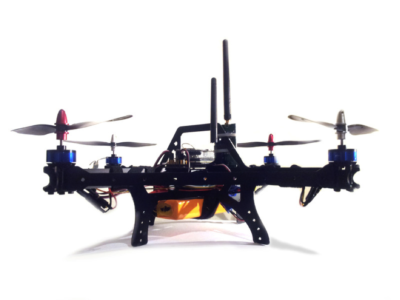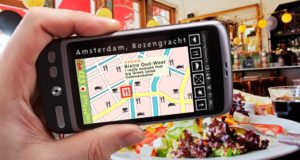Dronenet is a word like Internet—one that you’ll be hearing about in the years ahead. The dronenet is a powerful new technology that, like the Internet, could be a huge threat to your freedom or a tremendous tool for increasing your independence. One thing’s for sure: If the claims about dronenet are true, it will have a huge impact on our lives.
An Internet of Drones
So what is dronenet anyway? Basically, dronenet would be a large number of small flying drones that would deliver small payloads. We’ve all seen how, with present technology, drones can be programmed to deliver bombs or missiles on the battlefield. Dronenet is the next step; it would deliver small payloads, say tiny packages or letters, to a specific location. A good use for it might be sensitive documents or perhaps very small packages like prescription medicine to homes. The air would be filled with hundreds of tiny helicopter-like drones delivering things.
It would look like this: A network of computers would control small electrically powered drones via Wi-Fi. Since the drones would be lightweight and low powered, they’d be cheap, easy to build, and easy to operate. They wouldn’t fly that high, but they could enter homes and travel through city streets.
This idea may sound farfetched, but one of the top thinkers in preparedness today, Col. John Robb, thinks it is almost here. Remember how nobody talked about the Internet until it suddenly burst upon the scene back in the 1990s? Much the same could happen with the dronenet. Robb even calls it an “Internet of drones.”
Dronenet: the Good, the Bad, and the Very Ugly
The potential good of dronenet is that it would allow for fairly cheap, small-scale package delivery. It might make it easier for people to work from home and to receive or send out to small businesses. New businesses could proliferate. Another advantage is that it could reduce the use of delivery trucks and the use of fossil fuels, particularly gasoline.
The downside of dronenet is obvious: It would be a powerful surveillance tool for police, big business, or anybody else. Imagine hundreds of drones buzzing over the city, monitoring everybody and everything. Unlike surveillance cameras, they’d be hard to sabotage. Worse, they could be easily positioned to eavesdrop on conversations, spy on people (even in homes), or monitor communications. Drones could even use technologies such as infrared or deep radar to see through walls.
Yet dronenet would be far cheaper than surveillance cameras and far easier to deploy. It could be quickly withdrawn if there was public impact and then easily and quietly redeployed later. Authorities would try to present dronenet as a boon to public safety; they might note it could be used to catch drug dealers or bad drivers.
Another big problem is that, unlike traditional surveillance cameras, dronenet could easily be deployed in rural areas. Authorities could drop it out of aircraft at night. It might be posted in a particular region to see which rural families own guns, grow organic gardens, or are homeschooling children. Dronenet could be used to control rural activities such as hunting or use of the national forests.
Easy-to-implement surveillance would only be part of the menace of dronenet. The same drone that could easily be rigged to deliver a package could also be set up to drop a bomb, fire a missile, or carry a small gun. Drones could be deployed to disrupt crowds or to assassinate individuals. The dronenet could also be used to spray chemicals, including chemical weapons.
This may sound farfetched, but how many Americans in 1993 would have thought that U.S. remote-controlled planes would have been assassinating enemies in twenty years? Yet that’s exactly what’s happening.
Who Is Developing the Dronenet and Why?
An interesting question comes up here: Who is developing the dronenet and why? Col. Robb is or was a high-level military strategist—his sympathies are certainly with preppers—but he has a lot of contacts in the military industrial complex. Robb also gives a lot of speeches and talks to big business, the military, etc.
It’s obvious that somebody is putting a lot of thought and some money into the dronenet concept. We have to ask ourselves why and get scared. Is somebody out there developing next generation surveillance technology that seems perfectly geared to use in rural areas or semi-deserted cities?
The military might argue that the dronenet is being developed for the next war as an alternative to deploying large numbers of infantry to places like Afghanistan. Yet the same technologies could be used here in the U.S. to patrol cities in lieu of increasingly expensive policemen or in rural areas.
The Department of Homeland Security might see dronenet as a means of patrolling the border. The DHS is already experimenting with drones for border patrol work according to The New York Times, including along the Canadian border, where there is no real threat. The DHS might also see dronenet as a means of policing rural areas or combating domestic terrorism, particularly if it gets ordered to disarm rural residents or ban certain kinds of hunting (which has already happened in the United Kingdom). After all, hunting is unpopular in some quarters, and most voters don’t hunt.
Dronenet and the Bad Guys
If government abuse of dronenet wasn’t bad enough, what about everybody else? Criminals might use dronenet to distribute drugs or enforce some sort of protection racket. Perverts could use it to spy on people in their homes. Terrorists could use it to deliver bombs or spread chemical or biological weapons.
Just imagine what would happen if hundreds of small drones flew over a big city carrying explosives. The result could be massive amounts of destruction that authorities couldn’t stop. The drones could fly over the streets dropping grenades on pedestrians and cars or simply fly into buildings and explode.
History has shown us that such military technology spreads rapidly. In 1945, America’s leaders said nobody else would have an atomic bomb for decades; the Soviets tested their first nuclear bomb in 1949. Dronenet would be far easier to duplicate and deploy than an atomic bomb. Even a fairly small criminal or terrorist organization could build one.
Dronenet is one example of many new technologies that preppers need to be aware of. In the future, it could be used against average people or make it possible for average people to break free and stay free of big business and big government. We need to be aware of dronenet and start preparing for its effects because it is coming whether we want it to or not.
 Off The Grid News Better Ideas For Off The Grid Living
Off The Grid News Better Ideas For Off The Grid Living





